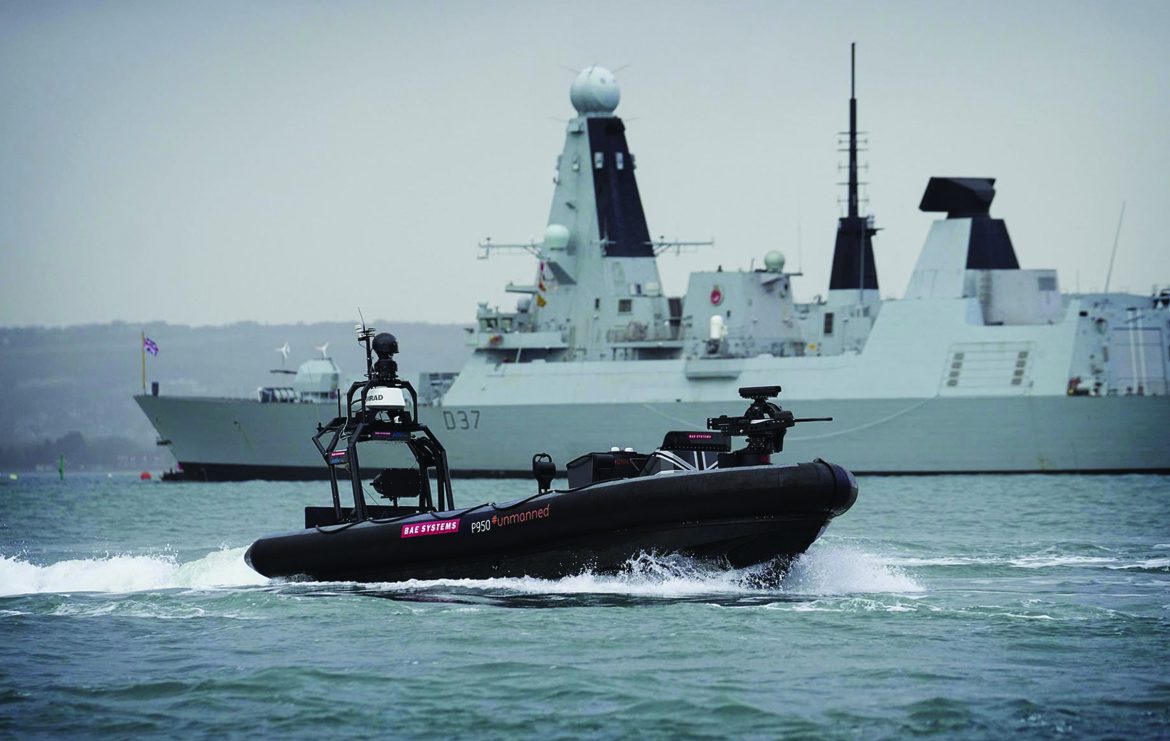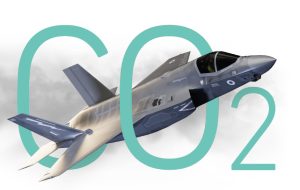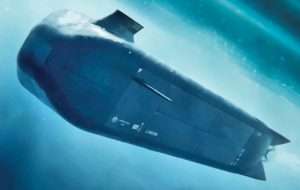Drones have clearly and repeatedly demonstrated their utility in military operations ashore. More recently Azerbaijan is using them successfully against Armenian forces. But drone usage has not been limited to states. Non-state actors have also had remarkable success. ISIS conducted over 80 attacks on Iraqi forces during four months in 2016 and Russian separatists in eastern Ukraine used drones to drop grenades that destroyed hundreds of thousands of tons of Ukrainian ammunition.
The American use of drones in the last 20 years of counterinsurgency and counterterror operations means virtually everyone is aware of the increasing capabilities and proliferation of military drones. In fact, there is no questioning the rapid improvements in these military platforms. But what is often overlooked has been the extensive use of commercially available and even locally built drones by Russian separatists, Ukrainian military units, and ISIS. For a fraction of the cost of military drones, these commercial units have provided a way for non-state actors to develop air power – however primitive.
Although they have not been used for attacks in the maritime domain yet, drones clearly have enormous potential to support maritime surveillance, reconnaissance, and strike missions – at a fraction of the cost of current systems.
Commercial Drones
Although most coverage of drones focuses on military and hobby uses, the use of drones by businesses to perform critical everyday tasks is growing exponentially. Business Insider Intelligence predicts drone sales will increase 66% per year over the next three years in four main sectors: agriculture, construction and mining, insurance, and media and telecommunications. The inevitable result will be rapid growth in capabilities and a decrease in cost of drones.
It is vitally important to remember we are returning to the normal condition of civilian led technological progress. Military and government research facilities pioneered many of the major technological advances from the 1940s until the 1990s. Prior to that period, most military useful technologies were developed by commercial entities. Since the 1990s, civilian firms have provided exponential increases in the capabilities of a wide range of technologies with military applications. This has been particularly true in the field of drones. While militaries have led the way in the development and deployment of very large and expensive drones, commercial firms have vastly expanded the capabilities of these platforms at orders of magnitude less cost. Planners should expect these improvements to continue at high and, at times, exponential rates. Thus they must keep an eye on commercial as well as military drone developments.
One of the key drivers of commercial drone technology is the desire for aerial drone delivery of packages to businesses and private residences. The requirements to execute this mission are: vertical takeoff and landing (VTOL), 1 meter delivery accuracy, GPS independent flight (to prevent loss of navigation where GPS signals are blocked), electronically hardened circuits (flight paths may take drones past powerful emitters), range, and payload. A quick scan of those attributes indicate they are almost exactly the same ones needed for a useful military drone.
Maritime operations
With that as background, we can turn to the potential of drones in the maritime domain. Maritime drones currently include unmanned aerial vehicles (UAVs), unmanned surface vehicles (USVs), and unmanned underwater vehicles (UUVs). Both military and civilian organizations are improving the performance of drones in each of these environments. Autonomous, semi-autonomous, and remote controlled drones are currently operational in each category. And, in the relatively confined waters of the Middle East, even relatively short-ranged land based drones can be critical players in the maritime arena.
Unmanned Aerial Vehicles
UAVs have already performed well in for long-endurance but low observable surveillance missions. Aerovel’s Flexrotor is a commercial leader in this class. Weighing only twenty-five kilograms and needing only a 6 meter by 6 meter operating pad, this vertical takeoff and landing drone provides long-endurance (thirty hours), visual, and infrared surveillance with live downlinks to a range of 160 kilometers. As early as 2016, it operated from icebreakers in the artic and yachts in Central America. It is designed to provide inexpensive aerial surveillance for border protection, fisheries control, search and rescue. At $200,000 a unit with low operating costs, the Flexrotor or drones with similar capabilities are clearly a vastly less expensive surveillance and reconnaissance platform than today’s manned aircraft or patrol boats.
In addition, technological advances have reduced the size of both synthetic aperture radars (SAR) and electronic warfare packages enough that it is practical to put these systems on aerial drones. The Promoco 150 UAV can execute a ten hour mission carrying SAR, electro-optical and infra-red systems. The Israelis have been operating and improving the Harop for over a decade. It carries electro-optical, infra-red, and electronic warfare sensors and has six-hour endurance and a 1,000 kilometer range. This loitering munition can be vertically launched from a canister ashore or at sea and be controlled via radio or operate autonomously. It is currently operated by six countries.
As noted above, firms are also working hard to develop UAVs for package delivery by quadcopters, fixed wing, and helicopter drones. Competition for drone delivery systems is intense and involves hundreds of companies worldwide producing drones that vary from inexpensive, local delivery systems to autonomous systems like Volans-I that can deliver up to 800 kilometers at speeds over 300 kilometers per hour. Drone Delivery Corporation Canada is nearing operational status on an autonomous helicopter drone that will deliver 180 kilograms out to 200 kilometers. Drones have delivered to offshore oil platforms and ships at sea. Clearly these systems have potential for surveillance, resupply, and even strike operations in a maritime environment.
For the military market, Kaman is improving the K-MAX unmanned, semi-autonomous helicopter that the U.S. Marine Corps used with remarkable success for two years in Afghanistan. It proved capable of lifting 2700 kilograms and sustained a 95% readiness rate throughout the two year deployment.
At the top end, air forces are experimenting with autonomous drones that will act as “loyal wingmen” to manned aircraft. The U.S. Air Force is testing the XQ-58A Valkyrie drone. It has a top speed of over 1,000 kilometers miles per hour, can deliver 260 kilograms of ordnance (two small-diameter bombs or air-to-air missiles) out to 2,500 kilometers, and, because it is VTOL-capable, does not require an airfield. Kratos offered the aircraft at $2 million a copy if purchased in lots of one hundred. While primarily being considered as a land-based drone, its long-range means the Valkyrie could provide air cover for maritime operations. Given its VTOL capability, it might even be adapted like the Harop to operate from ships much smaller than an aircraft carrier.
Unmanned Surface Vehicles
Commercial operators are seeking fully autonomous ships to cuts personnel costs and reduce accidents. Lloyds’ Register has even developed a scale to determine the level of autonomy for future ships – from 0 for no autonomy to 6 for a fully autonomous seagoing vessel. A Norwegian firm has already contracted for two autonomous ferries to operate in the inland waters of Oslo Fjord. But even the most optimistic estimates state that it will be a decade or more before fully autonomous commercial vehicles can safely sail the open ocean.
On the military side, the U.S. Navy is moving rapidly into unmanned surface vehicles. Secretary of Defense Mark Esper’s Battle Force 2045 envisions up to 150 unmanned naval vehicles by 2045. Even as the Navy looks well into the future, it has successfully sailed the Sea Hunter, an unmanned autonomous surface vehicle, from California to Hawaii and will integrate it into carrier strike group exercises in 2021. In its 2020 budget, the Navy requested $579.9 million in research and development funds for unmanned vehicles. It envisions large unmanned surface vehicles (LUSV) 30-60 meters long, displacing 1,000 to 2,000 tons, and equipped for anti-surface and strike warfare. Medium Unmanned Surface Vehicles will be 15-60 meters long, displace 500 tons, and focus on ISR and EW operations. It is also experimenting with autonomous swarms of small craft for maritime patrol of key passages. China has developed an unmanned surface vehicle remarkable similar to the Sea Hunter as well as armed smaller craft. The Royal Navy is also conducting experiments with unmanned surface vehicles.
Unmanned Undersea Vehicles
The U.S. Navy is also moving rapidly into unmanned underewater vehicles (UUSV). These include everything from the Orca Extra-large Unmanned Underwater Vehicle to very long endurance surveillance craft to self-deploying mines.
The Orca XLUUV is projected to have a range of 6,500 miles and an endurance of one month for autonomous operations. It will be capable of delivering a variety of payloads from sensors to weapons. The UK Ministry of Defense is also exploring the opportunities presented by this system. At roughly $50 million per unit, these provide a very economical alternative to manned submarines.
The U.S. Navy is investing in medium and small UUVs for a variety of missions from payload delivery to surveillance and patrolling. They are drawing on the experience of civilian researchers who for years have used UUVs in large numbers to conduct oceanographic surveys. Some of these vehicles can remain at sea for up to five years by exploiting temperature differentials in the thermocline and communicating via satellite during periods on the surface. These drones are particularly useful because they can operate in shallow coastal waters too dangerous even for small boats. The autonomous operation allows for hundreds to be deployed at a fraction of the cost of keeping a survey ship at sea. Some companies have developed swarms of drones that cooperate to survey an area at speeds vastly exceeding traditional techniques. By adapting the sensors on these vehicles, they can be used for security surveillance of maritime spaces.
They can also be used as weapons by changing the payloads delivered by medium and small drones to mines or torpedoes. For instance, the U.S. Navy Hammerhead mine will be deployed from unmanned underwater vehicles. It will loiter in an assigned patrol area to hunt for and sink enemy submarines.
Conclusion
Rapid technological advances driven by competition in both the military and commercial fields are providing remarkably capable drones that can provide support to maritime operations in the air, on the sea, and under the water. Of particular importance, they can do so a significantly less cost than current manned systems. National navies and commercial firms have just begun to explore the use of these systems. They clearly have the potential to radically change maritime operations globally.
» By: T. X. Hammes




















